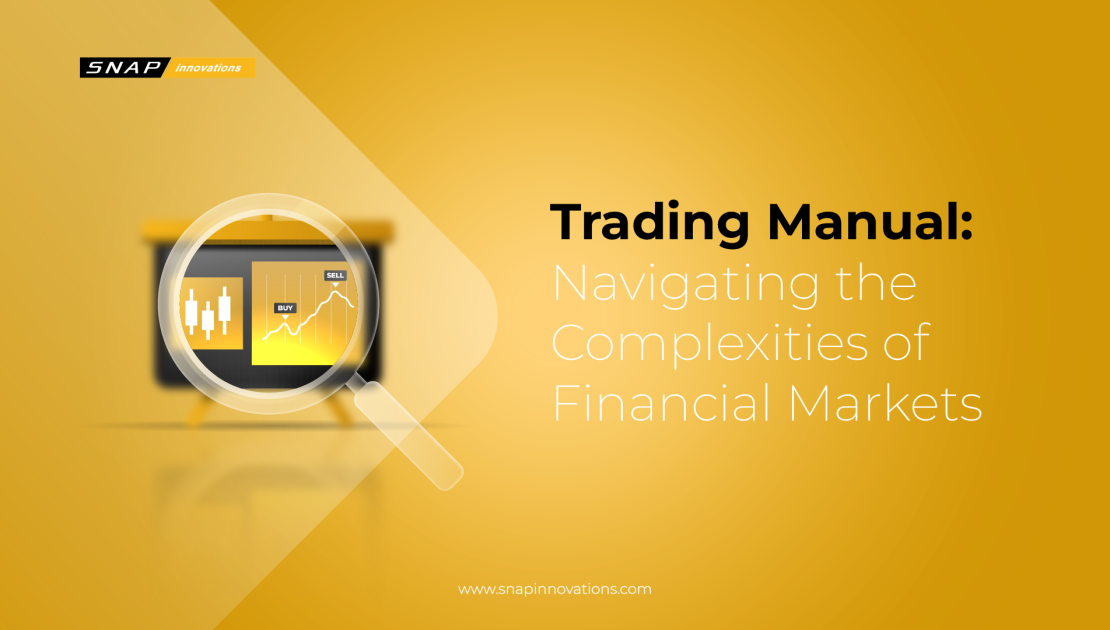Navigating the complex world of financial markets requires knowledge, skill, and strategy. Whether you’re a seasoned trader or just starting out, having a comprehensive trading manual at your disposal can make all the difference.
In this guide, we delve into the fundamentals of trading, exploring key concepts, strategies, and techniques to help you succeed in the dynamic world of finance. From understanding market dynamics to executing trades with precision, our trading manual serves as your ultimate resource for mastering the art of trading.
What is a Trading Manual?
A trading manual represents an extensive compendium of knowledge, serving as a cornerstone resource for traders seeking to navigate the intricate labyrinth of financial markets with finesse and precision. It transcends mere informational literature, embodying a comprehensive guide meticulously crafted to empower traders of all levels – from fledgling enthusiasts to seasoned professionals – with the requisite tools, strategies, and insights to traverse the dynamic landscape of finance with confidence and competence.
At its core, a trading manual is a compendium of wisdom distilled from years of market experience, offering a treasure trove of foundational concepts, advanced techniques, and practical methodologies meticulously curated to demystify the intricacies of trading and unlock the door to financial success. It serves as a beacon of enlightenment, illuminating the path towards trading mastery by providing in-depth explorations of market dynamics, analytical methodologies, risk management principles, and trade execution strategies.
From deciphering complex market indicators to devising sophisticated trading algorithms, a trading manual is a veritable encyclopedia of trading knowledge, meticulously organized and expertly elucidated to provide traders with the insights and expertise needed to thrive in the ever-evolving realm of finance. Whether you’re embarking on your trading journey for the first time or seeking to refine your existing strategies, a trading manual is an indispensable companion that empowers traders to navigate the tumultuous seas of financial markets with poise, proficiency, and perspicacity.
Components of a Trading Manual
 A trading manual typically consists of several key components, each designed to provide traders with essential information and guidance on navigating financial markets effectively.
A trading manual typically consists of several key components, each designed to provide traders with essential information and guidance on navigating financial markets effectively.
1. Market Overview
The market overview section of a trading manual is a comprehensive compendium that offers traders a panoramic vista of the financial markets. It delves deep into the labyrinthine corridors of market dynamics, providing an exhaustive exploration of various asset classes, trading hours, and the diverse array of market participants.
From the bustling floor of stock exchanges to the intricate web of global currencies, this section serves as a gateway to the complex world of financial markets, offering traders invaluable insights into the multifaceted tapestry of market activity.
2. Trading Basics
At the core of every successful trading venture lies a profound understanding of trading fundamentals, and the trading basics section of a trading manual serves as a foundational primer for traders of all levels. Here, traders are introduced to the fundamental concepts that underpin market operations, from the mechanics of market execution to the intricacies of order types and trade execution.
Through clear and concise explanations, supplemented by illustrative examples, traders gain a solid grounding in the fundamental principles of trading, empowering them to navigate the complexities of financial markets with confidence and proficiency.
Also Read: Trading Schools: Your Gateway to Becoming a Trading Expert
3. Technical Analysis
Technical analysis is an indispensable tool in the trader’s arsenal, and the technical analysis section of a trading manual provides traders with a comprehensive framework for analyzing market trends and identifying potential trade opportunities.
This section covers a wide range of technical analysis techniques, from chart patterns and indicators to support and resistance levels and trend analysis. By mastering the art of technical analysis, traders gain the ability to interpret price charts with precision, identify key market trends, and make informed trading decisions based on objective data and analysis.
4. Fundamental Analysis
In addition to technical analysis, fundamental analysis plays a crucial role in the trading process, and the fundamental analysis section of a trading manual provides traders with the tools and techniques they need to evaluate the intrinsic value of assets and assess market trends.
This section covers a broad range of fundamental analysis topics, including economic indicators, corporate earnings reports, and industry trends. By understanding the underlying factors driving market movements, traders can make more informed trading decisions and develop strategies that are grounded in solid fundamental analysis principles.
5. Risk Management
Successful trading is as much about managing risk as it is about identifying profitable opportunities, and the risk management section of a trading manual is dedicated to helping traders mitigate risk and protect their capital.
This section covers a variety of risk management techniques, including position sizing, stop-loss orders, and diversification. By implementing sound risk management practices, traders can limit their exposure to potential losses and safeguard their trading capital, ensuring that they can continue to trade effectively over the long term.
6. Trading Psychology
Trading psychology is another critical component of successful trading, and the trading psychology section of a trading manual explores the psychological factors that can influence trading behavior and decision-making.
This section covers a range of topics related to trading psychology, including emotional control, discipline, and mindset. By understanding the psychological aspects of trading, traders can develop the mental resilience and emotional intelligence needed to navigate the ups and downs of the market with confidence and composure.
7. Trade Execution
The final stage of the trading process is trade execution, and the trade execution section of a trading manual provides traders with practical guidance on how to execute trades effectively and efficiently.
This section covers a variety of trade execution techniques, including order placement, trade timing, and trade management. By mastering the art of trade execution, traders can ensure that their trades are executed at the best possible prices and that they can capitalize on market opportunities with precision and agility.
Strategies for Success of Trading Manual
 Success in trading requires more than just knowledge of market fundamentals and analysis techniques. It also requires effective strategies for managing risk, maximizing profits, and adapting to changing market conditions.
Success in trading requires more than just knowledge of market fundamentals and analysis techniques. It also requires effective strategies for managing risk, maximizing profits, and adapting to changing market conditions.
1. Risk Management Strategies
Effective risk management is paramount to successful trading, and a comprehensive trading manual provides traders with a plethora of strategies to mitigate risk and protect their capital. These strategies encompass various techniques such as determining appropriate position sizes based on risk tolerance, setting stop-loss orders to limit potential losses, and employing diversification across different asset classes to spread risk.
Additionally, traders are encouraged to regularly review and adjust their risk management strategies as market conditions evolve, ensuring that they can adapt to changing circumstances and preserve their trading capital over the long term.
2. Trade Planning and Analysis
A well-defined trade plan is essential for executing successful trades, and the trading manual offers traders guidance on developing robust trade plans tailored to their individual trading styles and objectives.
This includes conducting thorough market analysis to identify potential trade opportunities, establishing clear entry and exit criteria based on predefined trading rules, and incorporating risk-reward ratios to assess the potential profitability of trades. By meticulously planning their trades and adhering to predefined strategies, traders can enhance their trading discipline and improve their overall trading performance.
3. Technical Analysis Strategies
Technical analysis is a cornerstone of trading, and the trading manual equips traders with an extensive toolkit of technical analysis strategies to analyze price charts and identify profitable trading opportunities. These strategies encompass a wide range of technical indicators, chart patterns, and trend analysis techniques, allowing traders to assess market trends, identify key support and resistance levels, and anticipate potential price movements.
Additionally, traders are encouraged to combine multiple technical analysis tools to corroborate their trading signals and increase the reliability of their analysis, enabling them to make more informed trading decisions.
4. Fundamental Analysis Techniques
In addition to technical analysis, fundamental analysis plays a crucial role in trading, and the trading manual introduces traders to a variety of fundamental analysis techniques to assess the underlying value of assets and identify potential trading opportunities.
These techniques encompass analyzing economic indicators, corporate earnings reports, industry trends, and geopolitical events to gauge the overall health of the market and make informed trading decisions. By incorporating fundamental analysis into their trading strategies, traders can gain a deeper understanding of market fundamentals and capitalize on opportunities that may be overlooked by purely technical analysis approaches.
5. Trade Management Strategies
Effective trade management is essential for maximizing profits and minimizing losses, and the trading manual provides traders with a range of trade management strategies to optimize their trading performance. These strategies include setting realistic profit targets based on market conditions and adjusting stop-loss orders to protect profits and limit potential losses.
Additionally, traders are encouraged to employ trailing stop-loss orders to lock in profits as a trade moves in their favor and to use position sizing techniques to allocate capital effectively across different trades. By implementing robust trade management strategies, traders can enhance their overall trading profitability and reduce the impact of adverse market movements.
6. Psychological Strategies
Trading psychology plays a crucial role in trading success, and the trading manual delves into various psychological strategies to help traders overcome common emotional pitfalls and maintain a disciplined mindset. These strategies encompass techniques such as maintaining emotional control in the face of market volatility, cultivating patience and discipline to avoid impulsive trading decisions, and fostering confidence in one’s trading abilities.
Additionally, traders are encouraged to develop resilience to setbacks and losses, as well as to maintain a positive outlook even during challenging market conditions. By mastering their psychological state, traders can build the mental resilience needed to navigate the ups and downs of the market and stay focused on their long-term trading goals.
7. Continuous Learning and Adaptation
The final strategy for success outlined in the trading manual is a commitment to continuous learning and adaptation. The trading landscape is constantly evolving, with new market trends, technologies, and trading strategies emerging on a regular basis. As such, traders must remain vigilant in their quest for knowledge and be willing to adapt their trading strategies to changing market conditions.
This includes staying abreast of the latest market developments, attending trading seminars and workshops, and continuously refining their trading skills through practice and experience. By embracing a mindset of lifelong learning and adaptation, traders can stay ahead of the curve and position themselves for long-term success in the dynamic world of trading.
Tools and Resources of Trading Manual
 In the intricate and ever-evolving landscape of financial markets, traders are constantly seeking an edge to navigate the complexities and uncertainties with confidence and precision. A comprehensive trading manual serves as a veritable treasure trove, offering a rich tapestry of tools and resources that empower traders to traverse the markets effectively. At the forefront of these resources are sophisticated trading platforms, replete with a myriad of features such as customizable charts, real-time data feeds, and advanced order execution capabilities.
In the intricate and ever-evolving landscape of financial markets, traders are constantly seeking an edge to navigate the complexities and uncertainties with confidence and precision. A comprehensive trading manual serves as a veritable treasure trove, offering a rich tapestry of tools and resources that empower traders to traverse the markets effectively. At the forefront of these resources are sophisticated trading platforms, replete with a myriad of features such as customizable charts, real-time data feeds, and advanced order execution capabilities.
These platforms provide traders with a digital cockpit from which they can monitor market movements, execute trades swiftly, and analyze intricate market dynamics. Moreover, the trading manual underscores the importance of harnessing cutting-edge charting software, which enables traders to conduct in-depth technical analysis, identify emerging trends, and pinpoint potential entry and exit points with precision. Through the utilization of various indicators, overlays, and drawing tools, traders can gain deeper insights into market behavior, facilitating informed decision-making and strategic trade execution.
In addition to trading platforms and charting software, the trading manual sheds light on the wealth of financial news sources and research platforms available to traders. From reputable financial news websites to comprehensive research reports and market analysis tools, these resources provide traders with invaluable insights into global economic trends, geopolitical events, and sector-specific developments. By staying abreast of the latest market news and analysis, traders can make informed decisions, anticipate market movements, and capitalize on lucrative opportunities as they arise.
The Future of Trading Manual
As we peer into the horizon of financial markets, the trajectory of trading manuals is poised to undergo a profound transformation, driven by technological advancements, shifting market dynamics, and evolving trader preferences. One of the most significant trends shaping the future of trading manuals is the integration of artificial intelligence (AI) and machine learning algorithms, which promise to revolutionize how traders analyze data, identify patterns, and make trading decisions.
Also Read: Trading Roadmap: Your Guide to Navigating the Financial Markets
Furthermore, with the advent of blockchain technology, trading manuals are likely to embrace decentralized, transparent, and immutable ledger systems, enabling seamless trade execution, secure transaction settlement, and enhanced regulatory compliance. Additionally, the future of trading manuals will witness a proliferation of immersive, interactive learning experiences, leveraging virtual reality (VR) and augmented reality (AR) technologies to create simulated trading environments where traders can hone their skills, test strategies, and collaborate with peers in real-time.
Moreover, as environmental, social, and governance (ESG) considerations gain prominence in the investment landscape, trading manuals will incorporate comprehensive ESG frameworks, enabling traders to integrate sustainability criteria into their investment decisions and align their portfolios with their ethical values. In essence, the future of trading manuals holds boundless possibilities, poised to empower traders with cutting-edge technologies, actionable insights, and immersive learning experiences, driving innovation and excellence in the ever-evolving world of finance.
Conclusion
In conclusion, the significance of a trading manual cannot be overstated. It stands as a beacon of guidance for traders, illuminating the intricate pathways of financial markets and equipping them with the tools needed to navigate with confidence. Beyond being a mere compendium of knowledge, it serves as a trusted companion, offering insights into market dynamics, technical analysis techniques, and risk management strategies.
A trading manual is a treasure trove of wisdom, honed by experienced traders and industry experts, distilling years of trial, error, and success into actionable advice. It provides a roadmap for traders to traverse the volatile terrain of financial markets, enabling them to decipher market signals, anticipate trends, and seize lucrative opportunities


